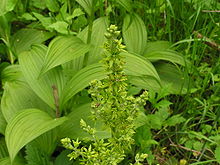- Veratrum viride
-
Veratrum viride Veratrum viride var. viride in flower Scientific classification Kingdom: Plantae (unranked): Angiosperms (unranked): Monocots Order: Liliales Family: Melanthiaceae Genus: Veratrum Species: V. viride Binomial name Veratrum viride
AitonVeratrum viride (Indian Poke, Indian Hellebore, False Hellebore, Green False Hellebore) is a species of Veratrum native to eastern and western (but not central) North America.[1][2][3] It is extremely toxic, and is considered a pest plant by farmers with livestock. The species has acquired a large number of common names within its native range, including American False Hellebore, American White Hellebore, Bear Corn, Big Hellebore, Corn Lily, Devils Bite, Duck Retten, Indian Hellebore, Itch-weed, Itchweed, Poor Annie, Blue Hellebore, and Tickleweed.
Each flower is 5–12 mm long, with six green to yellow-green tepals (Alpine Lakes Wilderness}
It is a herbaceous perennial plant reaching 0.7–2 m tall, with a solid green stem. The leaves are spirally arranged, 10–35 cm long and 5–20 cm broad, elliptic to broad lanceolate ending in a short point, heavily ribbed and hairy on the underside. The flowers are numerous, produced in a large branched inflorescence 30–70 cm tall; each flower is 5–12 mm long, with six green to yellow-green tepals. The fruit is a capsule 1.5–3 cm long, which splits into three sections at maturity to release the numerous flat 8–10 mm diameter seeds. The plant reproduces through rhizome growth as well as seeds.[1][4][5][6]
There are two varieties:[1]
- Veratrum viride var. viride. Eastern North America. Side branches of inflorescence erect or spreading.
- Veratrum viride var. eschscholzianum (Roemer & Schultes) Breitung. Western North America. Side branches of inflorescence drooping.
The related western North American Veratrum californicum (White False Hellebore, Corn Lily) can be distinguished from sympatric var. eschscholzianum by its whiter flowers, with erect side branches of the inflorescence.[6]
Distribution and habitat
In eastern North America, var. viride occurs from southwestern Labrador and southern Quebec south to northern Georgia. In the west, var. eschscholzianum occurs from Alaska and Northwest Territory south through Yukon, British Columbia, Alberta, Washington, Idaho, Montana, and Oregon to northern California.[1][3]
It is found in wet soils in meadows, sunny streambanks, and open forests, from sea level in the north of the range, up to 1,600 m in the southeast and 2,500 m in the southwest.[1][4][5]
Medicine
The plant is highly toxic, causing nausea and vomiting. If the poison is not evacuated, cold sweat and vertigo appears. Respiration slows, cardiac rhythm and blood pressure falls, eventually leading to death.
It is used externally by several Native American nations. Although is rarely ever used in modern herbalism due to its concentration of various alkaloids, it has been used in the past against high blood pressure and rapid heartbeat; a standardized extract of V. viride alkaloids known as alkavervir was used in the 1950s and 1960s as an antihypertensive.[7][8] The root contains even higher concentrations than the aerial parts.[9]
The plant was used by some tribes to elect a new leader. All the candidates would eat the root, and the last to start vomiting would become the new leader.[10]
References
- ^ a b c d e Flora of North America: Veratrum viride
- ^ USDA Plants Profile: Veratrum viride
- ^ a b Germplasm Resources Information Network: Veratrum viride
- ^ a b Plants of British Columbia: Veratrum viride
- ^ a b Jepson Flora Veratrum viride
- ^ a b Columbia River Gorge plants: Green False Hellebore
- ^ Council on Drugs (American Medical Association) (1964). New and Nonofficial Drugs. J. B. Lippincott. pp. 297–9. http://books.google.com/books?id=eY4wAAAAIAAJ&q=alkavervir&dq=alkavervir.
- ^ "alkavervir". Online Medical Dictionary. University of Newcastle upon Tyne Centre for Cancer Education. n.d.. http://cancerweb.ncl.ac.uk/cgi-bin/omd?alkavervir. Retrieved 2008-08-31.
- ^ Plants for a Future: Veratrum viride
- ^ Fleurbec Group (ed), 1981, Plantes cauvages comestibles. Saint-henri-de-Lévis, Quebec, Canada. ISBN 2-920174-03-7
Categories:- Veratrum
- Medicinal plants
- Poisonous plants
Wikimedia Foundation. 2010.


